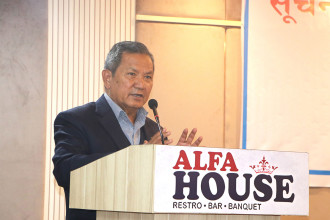KATHMANDU: Kangchenjunga Conservation Area Management Council (KCAMC) and Samriddha Pahad on Thursday proposed the nomination of Kangchenjunga Conservation Area to become a UNESCO Biosphere Reserve during celebrations marking 70 years since the first successful ascent of Kangchenjunga.
A UNESCO Biosphere Reserve supports local communities in preserving the natural resources and biodiversity of designated locations. The Kangchenjunga Conservation Area is striving to be Nepal’s first UNESCO Biosphere Reserve.
Jaco Du Toit, UNESCO’s Representative to Nepal, remarked, “The area is a good example of where people and nature live together.” Barsha Lekhi, UNESCO’s Indigenous Engagement Specialist, is currently assessing the feasibility of this nomination, with talks expected to advance in the future.
Sanjeev Neupane, CEO of Samriddha Pahad, presented the five pillars supporting Kangchenjunga’s nomination through a documentary shared with the audience. These pillars include environmental and biodiversity conservation aimed at safeguarding ecosystems and wildlife, sustainable tourism infrastructure designed to protect the environment while supporting the livelihoods of local communities and enhancing tourists’ comfort, community human capital and economic development such as a porter training school partnered with the Nepal Mountaineering Institute, smart technologies to enhance safety and connectivity by incorporating modern innovations, and destination marketing aimed at attracting visitors.
Kangchenjunga, a mountain steeped in historical significance for the Rai, Limbu, and Sherpa communities, was first summited on May 25, 1955, by Joe Brown and George Band. A documentary recounting their expedition, entitled “Five Treasures of the Snow” and produced by John Porter, was screened as part of the Diamond Jubilee celebrations of their achievement. The name Kangchenjunga, derived from Tibetan, translates to the title of Porter’s documentary. For local residents, the five treasures symbolise gold, silver, grain, gems, and sacred texts.
WWF’s Snow Leopard Champion, Ghana Shyam Gurung, highlighted Kangchenjunga’s biodiversity as a treasure to be preserved. The area serves as an essential habitat for snow leopards and red pandas. Kangchenjunga’s five distinct peaks, along with its lower surroundings, hold profound significance for the wildlife that inhabits the region. Gurung advocated that hydropower plants in this area should be built only below an altitude of 3,000 metres.
Khagendra Phembu Limbu, Chairman of KCAMC, called for financial and promotional support to preserve Kangchenjunga and its surrounding areas as they currently stand.
The first Nepali Kangchenjunga summiteers—Ang Phurba Sherpa, Niam Jangmu Sherpa, Nima Dorje Sherpa, and Pemba Tsering Sherpa—were honoured during the event. Guest speakers who share a connection with Kangchenjunga, the world’s third-highest mountain, were also present.
A roundtable discussion took place, moderated by writer Lisa Choegyal. The panel included Ang Phuri Sherpa, Country Director of the Red Panda Network; Rohini Khanal, Senior Officer at the Nepal Tourism Board; Tenzing Chogyal Sherpa, Cryosphere Analyst at ICIMOD; Barsha Lekhi, Project Officer and Indigenous Engagement Specialist at UNESCO; and Ratan Bahadur Budathoki, Project Leader at Nepal SNV Netherlands Development Organisation. The panel shared their expertise on Kangchenjunga’s conservation initiatives and addressed the impact of external factors on an ecosystem in need of protection.





-1745575590.jpeg)